Native
Exotic, but established
Exotic
Eucosmini is the most diverse tribe of Olethreutinae, with approximately 1,650 described species that occur worldwide. No single synapomorphy is known which defines the tribe, but one potential synapomorphy that has been proposed is the base of vein M2 bent towards the stalked base of veins M3 and CuA1 in the hindwing, though exceptions exist (Horak 2006Horak 2006:
Horak, M. 2006. Olethreutine moths of Australia (Lepidoptera: Tortricidae). Monographs on Australian Lepidoptera, Vol. 10. 522 pp.). Molecular data suggest Eucosmini to be sister to Grapholitini (Regier et al. 2012Regier et al. 2012:
Regier J. C., Brown, J. W., Mitter, C., Baixeras, J., Cho, S., Cummings, P., Zwick, A. 2012. A molecular phylogeny for the leaf-roller moths (Lepidoptera: Tortricidae) and its implications for classification and life history evolution. PLoS ONE. 7(4): e35574.). Morphological similarities, especially in the genitalia support this relationship.
Adults of Eucosmini are difficult to generalize externally, but most have relatively narrow forewings with well-defined paired costal strigulaecostal strigulae:
small, usually pale, semirectangular marks along the costa 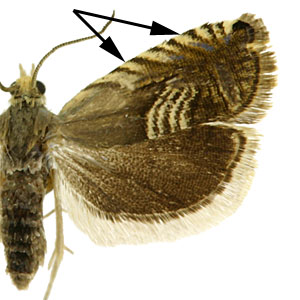 , a variably-developed ocellusocellus:
, a variably-developed ocellusocellus:
forewing pattern element - an ovoid region anterior to the tornus; adult head - a simple insect "eye" located dorsal to the compound eye 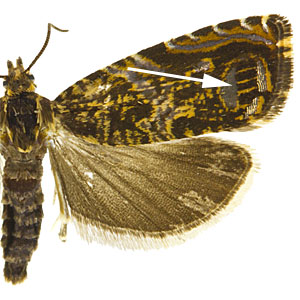 , and often forewings with dull brown, tan, white, or red coloration (though colorful exceptions certainly exist). Male genitalia are variable, but can often be characterized by an obsolete or reduced uncusuncus:
, and often forewings with dull brown, tan, white, or red coloration (though colorful exceptions certainly exist). Male genitalia are variable, but can often be characterized by an obsolete or reduced uncusuncus:
a sclerotized process which is fused to the posterodorsal margin of tergum IX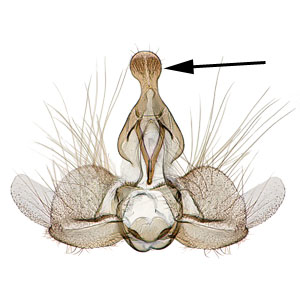 ; nub- or lobe-like sociisocii:
; nub- or lobe-like sociisocii:
a pair of lightly sclerotized setose lobes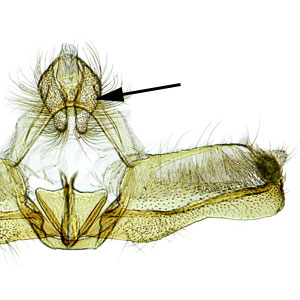 ; and valvaevalvae:
; and valvaevalvae:
plural of "valva" with a distinct constriction or “neck” at the midpoint with a well-developed cuculluscucullus:
with a distinct constriction or “neck” at the midpoint with a well-developed cuculluscucullus:
the distal portion of the male valva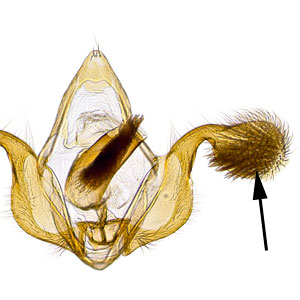 , often with spine-like setae on the distaldistal:
, often with spine-like setae on the distaldistal:
farthest from body, distant from point of attachment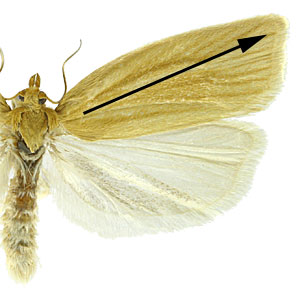 margin. Female genitalia are equally variable, but usually have a large, plate-like sterigmasterigma:
margin. Female genitalia are equally variable, but usually have a large, plate-like sterigmasterigma:
the sclerotized region surrounding the female ostium bursae 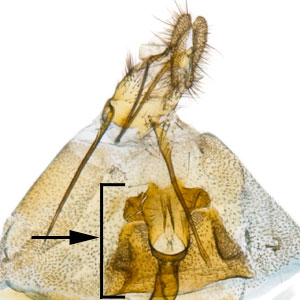 , the shape of which is often taxonomically useful; a ductus bursaeductus bursae:
, the shape of which is often taxonomically useful; a ductus bursaeductus bursae:
a membranous tube connecting the ostium bursae to the corpus bursae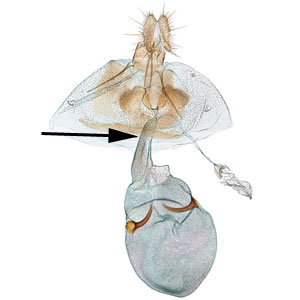 that is at least partially sclerotizedsclerotized:
that is at least partially sclerotizedsclerotized:
hardened; usually in reference to larval structures or adult genitalia  ; and a corpus bursaecorpus bursae:
; and a corpus bursaecorpus bursae:
a dilated membranous sac at the anterior end of the bursa copulatrix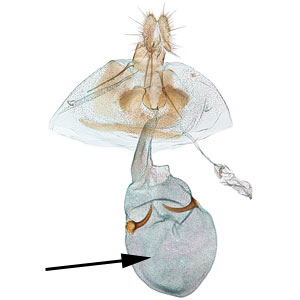 with two horn- or blade-like signasigna:
with two horn- or blade-like signasigna:
plural of "signum"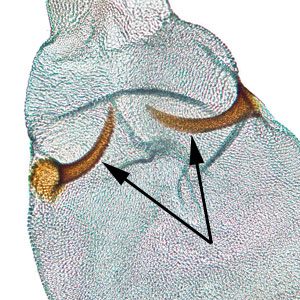 .
.
Like most other olethreutines and opposed to most tortricines, eggs of Eucosmini tend to be laid singly and without colleterial secretions to cover them. The larvae of Eucosmini display a wide variety of life histories, but most are leaf-rollers, leaf-webbers, or stem and root borers. Despite their diversity, relatively few species are considered serious pests. On this site, we include some of the most common Nearctic species which researchers, surveyors, and inspectors are likely to encounter.
The foundation and most comprehensive guide to Nearctic Eucosmini is Heinrich (1923), but more recent regional (Miller 1987; Gilligan et al. 2008Gilligan et al. 2008:
Gilligan, T. M., Wright, D. J., Gibson, L. D. 2008. Olethreutine moths of the midwestern United States, an identification guide. Ohio Biological Survey, Columbus, Ohio. 334 pp.) and genus-level (Mutuura & Freeman; 1966; Powell & Miller 1978Miller 1978:
Miller, W. E. 1978. Petrova pitch-blister moths of North America and Europe: two new species and synopsis (Olethreutidae). Annals of the Entomological Society of America. 71: 329-340.; Powell 1978; Miller 1986Miller 1986:
Miller, W. E. 1986. The species of Pseudexentera (Tortricidae). Journal of the Lepidopteristsrsquo; Society. 40: 218-237.; Wright & Gilligan 2015; Wright & Gilligan 2017) treatments exist.
Included species:
Exotic species
Exotic, but established species
Gypsonoma aceriana
Native species
Chimoptesis pennsylvaniana
Crocidosema spp.
Crocidosema lantana
Crocidosema plebejana
Epiblema otiosana
Epiblema strenuana
Epinotia spp.
Eucopina spp.
Eucosma parmatana
Gretchena bolliana
Gypsonoma haimbachiana
Hendecaneura shawiana
Pelochrista derelicta
Proteoteras aesculana
Proteoteras crescentana
Proteoteras moffatiana
Retinia spp.
Rhyacionia spp.
Strepsicrates smithiana
Suleima helianthana
View full screen host table here